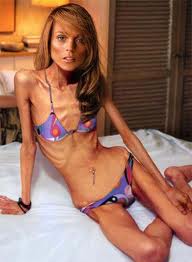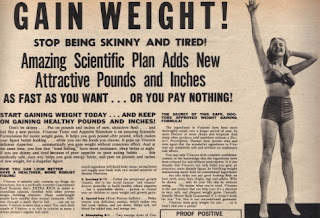“…to depict such images in contexts that give them positive connotation and credibility. Images, for example, of starving Ethiopian women feature often in the Western news but would never be attributed with anorexic causation. Yet, since the 1990s, median images of often equally skeletal young white women were and are systematically deemed as suicidally inspirational by a range of authoritative institutions. (Wykes/Gunter, 209)
Starving

Sexy

The message associated with imagery makes all the difference. If the starving Ethiopian woman was wearing the latest in Louis Vuitton fashion she would be considered “attractive” or even vibrant and healthy.
and the results....
becomes...
The association with anxiety and body image is undeniably gender biased and the typical victims of this association are women.
“…Researchers found that : 50% of the commercials aimed at girls spoke about physical attractiveness, while none of the commercials aimed at boys referenced appearance”. (Media’s effect on Girls: Body Image and Gender Identity)
Advertisers aim to elevate anxiety in their audience. They also provide relief from that anxiety with their product. As a result you have a “solution” that makes you feel good and the association of that feeling makes you buy their product. A negative image of a large woman creates the anxiety but the diet pill is the solution to the anxiety.
“Psychologists have shown that a negative message which succeeds in arousing anxiety or fear creates a secondary drive and a reduction of the fear or anxiety thus created has been shown to constitute an effective kind of reinforcement.” (Wheatley/Oshikawa, 85)
What can you present to advertisers as a better way to appeal to consumers? If you define “better” as “more profitable” then the challenge becomes how to prove Company X will make more money without appealing to social constructs and insecurities perpetuated by the media, i.e. women and appearance.
MS. Magazine attempted to “convince makers of ‘people products’ used by both men and women…..cars, credit cards, insurance, sound equipment, financial services and the like – that their ads should be placed in a women’s magazine.” (Steinem, 112)
Advertisers don’t stray easily from proven strategies, even when those strategies are out of date and ineffective. As MS. Magazine experienced, even with proven statistics, they were rarely successfull in changing the minds of the establishment.
So what changes advertiser strategies?
Sex sells and advertisers know this but it seems the solution to gender bias criticism is to sexualize men as well as women. Once again advertisers appeal to base insecurities instead of diversifying and creating a healthier message. The question still remains...
Is it advertising or society at fault?
As you can see in the images below advertising have changed dramatically in the 20th century.
http://www.healthylivingindia.org
In order to change the advertising industry we need to change our concepts of gender stereotypes as well as what's healthy. It's hard to say what caused the shift between the examples above but the solution is an educated population and their ability to reject these messages. A part of the solution lies in the diversity of your message, in long tail advertising. As Ms. magazine suggested, by removing the gender bias you appeal to twice as many consumers.
Diversity in advertising has always been more expensive than appealing to a pre-defined group of people that encourages the perpetuation of gender roles and targeted marketing. The internet gives us the opportunity to experiment with appealing to different markets at little cost and without steriotypes
Appealing to base insecurities and stereotypes will always exist but it can be overshadowed with a variety of healthy non-sexist, non racist messages but it's our job to accept them and who doesn't want to be healthy?
Diversity in advertising has always been more expensive than appealing to a pre-defined group of people that encourages the perpetuation of gender roles and targeted marketing. The internet gives us the opportunity to experiment with appealing to different markets at little cost and without steriotypes
Appealing to base insecurities and stereotypes will always exist but it can be overshadowed with a variety of healthy non-sexist, non racist messages but it's our job to accept them and who doesn't want to be healthy?
Sources
Conclusion: Body Messages and Body meanings
Media’s Effect on Teenager Behavior (October, 2008)
Journal of Marketing research, Vil VII (February 1970) 85-9





I like your focus on the root of the problem here. Advertisers show the images they do because they have found that they are lucrative; they are a means to an end, the end being, as usual, money. I agree that bringing attention to different ways they (advertisers) can continue to make money through different methods is extremely important. We can't expect advertisers to shift strategies that have unfortunately seemed to work for so long, so following Steinam's example, (though she herself was unfortunately not very successful) I agree that opening advertisers' eyes to the many other ways they could be making money without distorting the reality of women's images could be key.
ReplyDeleteMr. Spaghettiman:
ReplyDeleteIt is ironic that depicting a starving person without an endorsement goes unnoticed by many, but put a Pepsi in that person's hand and the Adman can get an impulse by the viewer to buy. I like how you displayed your samples in the same line per se; because I immediately saw an ad connection with the women in dress - ignoring her unconscious plight (she too is starving). Tells me how we are conditioned to see an image, without seeing the person and that the "Superstructure" has been pretty successful for men in my "market range." Body messaging is a resourceful tool for making money. You clearly placed a big question mark on how and why we play into this; while the obvious go on starving. Thanks for the insight.
Louis
I find it incredible that advertising almost always touches upon the subject of physical attraction among women and hardly ever critiques men. For a long time men could look like ANYTHING as long as they had a fat wallet. Women were meant to attract these aristocratic and abundant bachelors using their physical image. I find this rather fascinating just because in most species males are the ones who show off their beauty to attract females. I immediately think of the male peacock that showcases his beautiful colors to impress female peahens.
ReplyDeleteOf course, nowadays advertisers are targeting male insecurities and raising their anxieties about 6-packs and bigger arms and using their egos to sell back a feeling of masculinity and power over subordinate women. This feeling I mentioned is portrayed all the time in advertising for fragrances, clothes, liquors, etc…
I also agree that advertising should maintain a high level of diversity, but these powerful advertisers are only concerned about chasing the next dollar and do not want to risk losing money on an ad campaign that may not provide their clients with the same amount of financial gain that their torturous method has managed to do for so long.
And that image of the girls sucking in their stomachs comes across as playful, but it does send a slight message that that would be ideal and many girls succomb to taking that very seriously. This is where the damage begins.
I agree with the above statement when Alexander said that men can look like anything as long as they have fat wallets. Not to put blame solely on the advertising industry because they only feed into what we give them and vice versa. If nobody takes a stand and says "we're not going to continue purchasing your products" then that only gives them the belief that their marketing strategies are sending out a positive message to society. If nobody takes a stand advertisers will continue to push the envelope until they have finally created ads like the Tom Ford images or the image of the man crushing a woman's skull with his foot. People have become too co-dependent on the media to truly ever turn their heads away and advertisers know this. They use it to their advantage. People live in ignorance and someone like Donatella Versace live in a state of bliss, who's gotten comfortable with the lifestyle she has been accustomed to. They are not going to change their way of marketing their products, even if it's the wrong way, when money is involved.
ReplyDelete